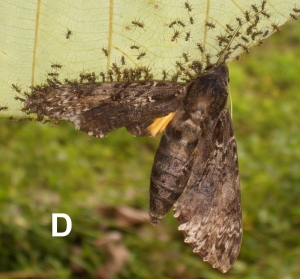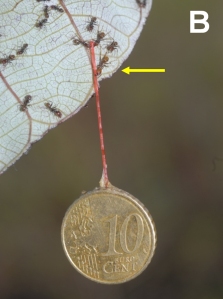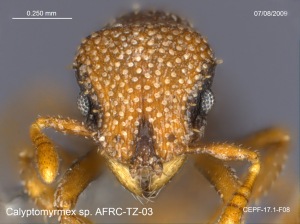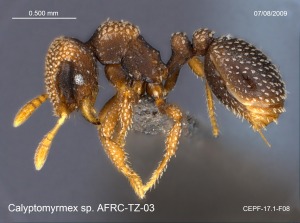Filed under: Uncategorized
Reading scientific articles is part of scientist every day job. I have to say that if I find that many papers can be classified as interesting for my research, but not necessarily exciting to read (even sometimes boring). The goal of a scientific article is not be exciting but to be useful, to make a point. Having undergraduate students working around, it is easy to tell that they are not extremely enthusiast about reading scientific articles in general. However, once in a while, some exciting papers are published that, I believe, will enthusiast most of their readers and could become one of those examples that professors can then use to explain a concept to their students. Students that could even enjoy them!
On arboreal ants, I can think about a few like this that came out over the past years such as the gliding Cephalotes and the red berry Cephalotes (infected by a nematode) of Steve Yanoviak, the devil gardens of Myrmelachista of Frederickson, or the trapping techniques of Allomerus by Dejean. In a new article, still by Dejean and collaborators published in PlosOne, ants reveal one more time some really cool example of adaptations to capture prey. Like the three previous examples, arboreal ants are involved. In this case, Azteca species use the structure of the leaves of their host plant to capture preys… huge preys! Up to 13000 times their own weight. And the authors to compare this with a 70 kg human being able to capture a 935 tons prey.
Wait a second, 935 tons… what could weight that much? That is about eight Boeings 757 full of passengers, or also the weight of a destroyer during the Second World War… Amazing!
The pictures provided in the article are great and talk for themselves. Also, do not miss the video in the supplement (it has the quality of a documentary).
Now the interest of the article is also to show that the relation between the plant species and the ant species is fundamental for the success of prey capture, as well as the side of the leaf used by ants to capture large sized prey. This provides a good example of the different benefits perceived by ants on different myrmecophytic plants.
Here is the link to the article:
http://www.plosone.org/article/info:doi/10.1371/journal.pone.0011331
Enjoy!
The last update of the ant generic database is only a month old, and I am glad to announce that no less than 110 additions/changes have been made since then.
Most of the modifications this time concerns regions of Asia and especially China where I have been able to find lots of new records for specific provinces. The difficulty I have since the beginning of this project for some regions like China has been to find and then understand the publications. Most of the work realized on Chinese ants has been published in Chinese journal which seems to have a limited distribution. The first difficulty has been to find the references of the different articles and then to obtain a copy of them. Hopefully for me, NCSU has an excellent library service! Thanks to them I have been able to have access to hundreds of articles and books which sometimes are mailed from the other side of the world just for my insatiable bulimia of data collection. The second difficulty is of course the reading. Reading Chinese is not an easy thing to do, especially when you don’t understand it, but fortunately, the format of scientific paper coupled with the access to Internet and tools of translation allow me to extract the information I need. At many occasions, I though about the perseverance of Champollion who pierced the secrets of Egyptian hieroglyphs on the Rosetta Stone.
Anyway, the maps have now 96 new records (green), 11 new interpolations (blue) and 3 new records for introduced genus (orange).
Besides China, a few records have been added for South East Asia, Central Asia, South America or Africa.
While most novelties are only novelties in a sense that I did not came across those references earlier, there is a real new one with the discovery of Asphinctopone by Peter Hawkes in Tanzania (published in Zootaxa). This new record extends the range of this Ponerine genus on the East coast of Africa and is also at the same time the southern record. Needless to say that this is a pretty cool new record!
I also found very interesting the position of Peter Hawkes who is the director of a company specialized in the monitoring of arthropods diversity in Africa, called Afribugs. I believe that it is during one of those monitoring, that Peter has discovered the new Asphinctopone species. On the website of Afribugs, you could learn about the company but also see some of the awesome specimens collected.
For instance, this nice species of Calyptomyrmex collected also in Tanzania. Take a look!



